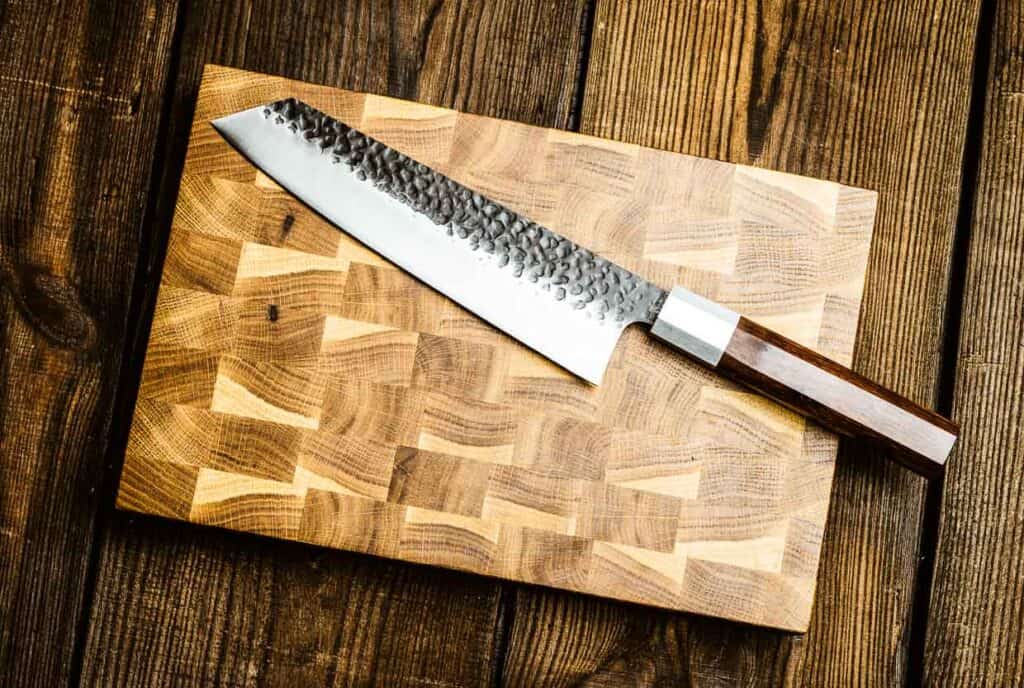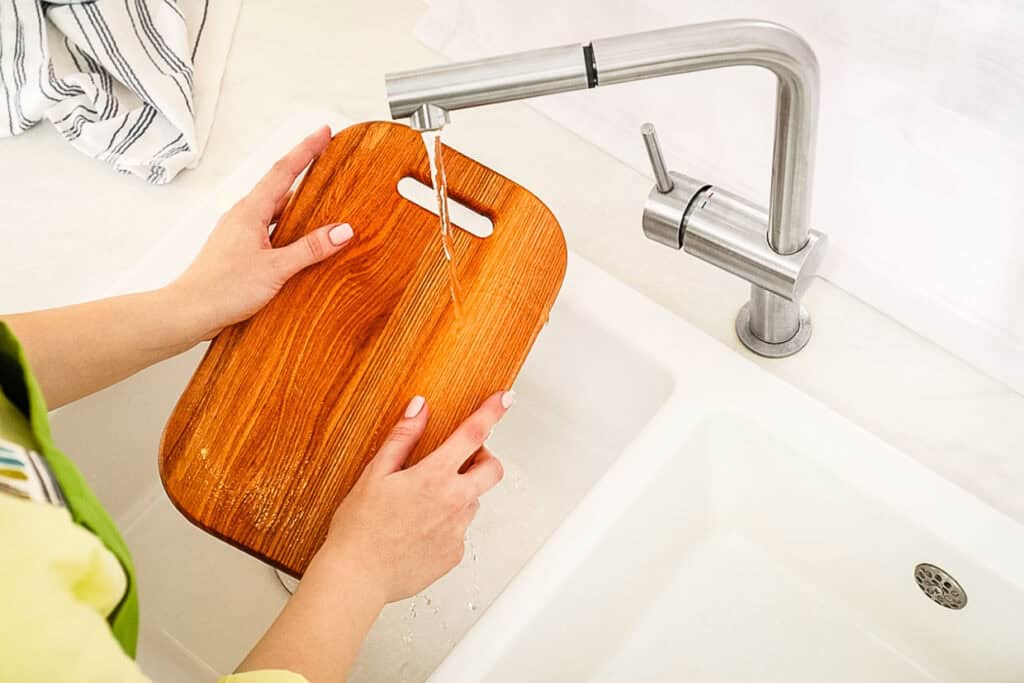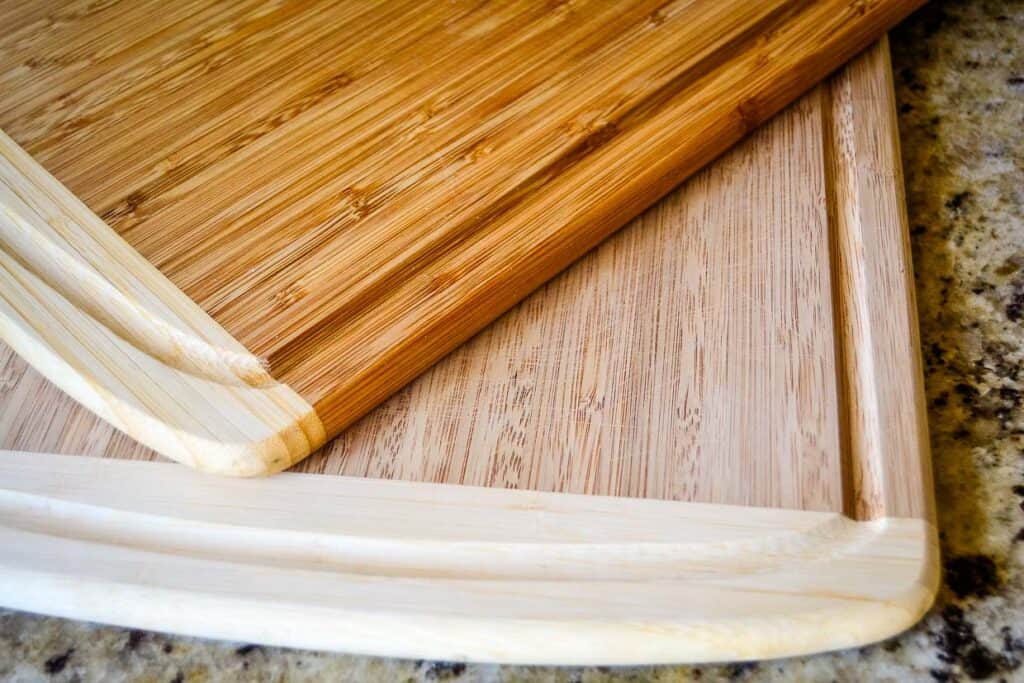Known for their beauty and durability, natural grain cutting boards, like bamboo and wood, add a touch of timeless elegance to your kitchen. With these expert tips for bamboo and wooden cutting board care, you can maintain your boards as reliable food prep surfaces for years.

The importance of bamboo and wooden cutting board care
The secret to a long-lasting cutting board is regular maintenance. While some types of cutting boards only require minimal care, the same does not apply to wooden and bamboo surfaces. These natural surfaces require more effort in cleaning, sanitizing and oiling to maintain their beauty.
While you must clean your boards after every use, other maintenance steps, like stain removal and sanitizing, are done as needed. Additionally, oiling your boards on occasion will keep the wood in its best condition, helping to prevent stains and odors from penetrating the surface in the first place.
Cleaning
I would never purchase a new kitchen appliance or gadget without knowing how much effort is required to keep it clean, and it’s no different when choosing the right cutting board. While the dishwasher makes for easy cleaning of boards made from plastic and composite, bamboo and wood boards must be hand-washed and thoroughly dried before storing.
The easiest way to clean wood or bamboo is with a soft bristle brush and a mild dish soap. You don’t need any specialized products; the dish soap you use to clean your favorite coffee mug will do an excellent job cleaning your cutting boards. Avoid harsh chemicals or abrasive scrubbers, as they can damage the surface. Follow these steps to clean your wood or bamboo board properly:
- Rinse the cutting board to remove any food residue.
- Add a small amount of soap to a soft-bristle scrub brush, then gently scrub both sides of the board. The bristles will quickly remove any food remnants that may have made their way into the knife cuts or scratches on the board surface.
- Once clean, rinse the board to remove all the soap.
- Allow it to drain vertically, then thoroughly dry the board with a soft cloth.
- Stand the board back on its edge and let it air dry completely before storing it away for the next time.

Sanitizing
Many types of wood and bamboo possess natural antibacterial properties. Still, if you ever use your board for animal proteins or inadvertently cut into a rotten watermelon or moldy onion while practicing your knife skills, you must know how to sanitize your board correctly. You can do this with adequately diluted vinegar or bleach.
- To sanitize with vinegar: Dilute one part of basic white vinegar to four parts of water.
- To sanitize with bleach: Dilute one tablespoon of bleach in half a gallon of water.
Once you have mixed your cleaning solution, ensure your board has been thoroughly washed and towel-dried. Rub the solution into the board’s surface using a sponge, paying particular attention to any worn areas that may have more knife gouges. Allow the solution to penetrate for two minutes, then rinse thoroughly with hot water. Drain and dry your board the same way you would when cleaning it.
Deodorizing
If your bamboo or wooden cutting board has picked up an off-putting smell, there are methods to deodorize it and restore it to its previously odorless state. Often, the smell comes from bacteria trapped in the board’s surface, so I recommend you start by sanitizing with either bleach or vinegar as the first line of defense. If that doesn’t work, baking soda can do wonders for funky smells.
Simply sprinkle a thin layer of dry baking soda on the board’s surface and let it absorb for a few hours. For strong odors, like the ones you may get from slicing onions, you may need to let the baking soda sit overnight. The key here is to use dry baking soda, not a wet paste, as too much moisture exposure can damage the wood or bamboo.
Stain removal and prevention
When working with bold-colored fruits and vegetables known for staining, like beets and berries, it is important to know how to remove these stains from your cutting surfaces without damaging your boards. Even better is having a trick or two up your sleeve to prevent these stains in the first place.
The easiest line of defense against stains is to wet your board before you start chopping things that will stain. It’s not foolproof, but when the board has already soaked up a layer of water, it’s harder to soak up the natural colors of these foods. It works even better when used on an adequately oiled board.
If your board does get a stain, coarse salt and half of a lemon make for a great stain remover. Sprinkle the cut side of the lemon with the salt, then rub it into the stained surface of the board. The salt is not coarse enough to damage the grain of the bamboo or wood, but it is sufficient for scrubbing. Combined with the natural acidity of the lemon, it will remove most stains.

Oiling
Benjamin Franklin has been quoted as saying, “An ounce of prevention is worth a pound of cure.” While I’m fairly certain he wasn’t referring to bamboo and wooden cutting board care, the sentiment applies. Naturally porous surfaces, both bamboo and wood, are prone to drying out. Once dry, they are more susceptible to soaking up the stains, smells and bacteria we work hard to remove. To prevent these issues from occurring in the first place, you should regularly oil your cutting boards.
It’s as simple as rubbing the boards with oil, allowing them time to soak it all in, and then washing to remove any excess before drying and storing the boards. Be sure to use food-grade mineral oil or a wood conditioner explicitly created for the job. My personal favorite is Howard Butcher Block Conditioner, which is a combination of mineral oil and natural waxes.
Use a soft cloth to apply a thin layer of oil to the entire surface of the board. Go over the board a second time with the same cloth to buff the oil into the surface. Rest the board vertically on one end and allow it to sit overnight to soak up as much oil as it needs.
The next day, wash and dry the board as normal to remove any remaining oil. This process should be repeated as needed whenever your boards appear dry or lose their sheen. In some kitchens, this is done monthly, but for others, it’s only done a few times a year.
Common mistakes to avoid
As with any kitchen task, there are always common mistakes to avoid when learning about bamboo and wooden cutting board care. The biggest enemy of wood and bamboo boards is prolonged exposure to water, and the biggest mistakes in using them all relate to that.
When using wood or bamboo cutting boards, do not soak them in water. Do not put them in the dishwasher or leave them in a wet sink overnight. When drying, ensure they have adequate airflow and the flat surfaces aren’t fully touching. Any of these mistakes can cause your boards to warp, crack or grow mold, making them difficult to use and unsafe in the kitchen. Avoiding these mistakes will enable you to keep your cutting boards beautiful for years to come.
Renee N Gardner is the creative mastermind behind Renee Nicole’s Kitchen, a recipe blog based on seasonal ingredients, dedicated to helping home cooks build their kitchen confidence to become home chefs. When Renee isn’t writing, developing recipes or photographing food, you’ll find her in the garden, traveling or enjoying the outdoors with her husband, son and two dogs.